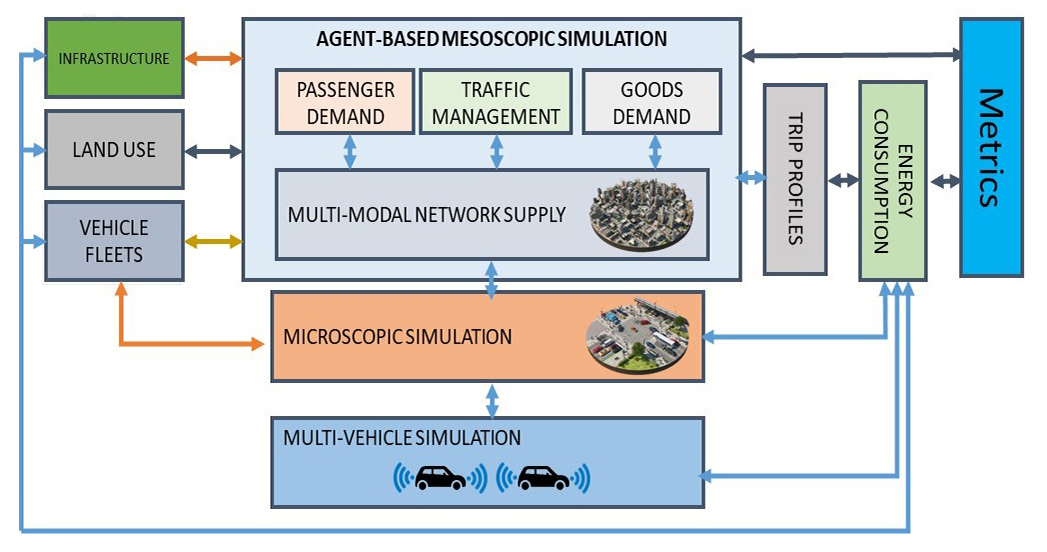Emerging mobility technologies such as electrification, connectivity and automated vehicles can have myriad effects on a given city’s transportation network. Whether these effects are relatively positive or negative depends on a number of factors, including how multiple technologies simultaneously deployed may intensify or offset one other. Scientists within Argonne National Laboratory’s Center for Transportation Research organization are working to understand and evaluate this interplay of technologies and their effects on transportation networks.
“Not every new mobility technology will improve a city’s transportation network,” said Aymeric Rousseau, Vehicle and Mobility Systems Manager. “On one hand, connected vehicles can improve traffic flow by minimizing the distance between cars, thus decreasing congestion.” However, he continued, autonomous vehicles, with their convenient operation and the way they allow travelers to engage in other activities than driving, also have the potential to exacerbate congestion by increasing vehicle miles traveled—that is, the amount of travel for all vehicles in a geographic region over a given period of time.
Public transit networks, electric vehicle charging stations, connected and autonomous vehicles, e-commerce and freight and logistics management; all operate as systems unto themselves within a larger transportation network. “Many of these systems are being studied and modeled individually,” said Principal Computational Transportation Engineer Joshua Auld. “What makes Argonne’s transportation workflow so crucial for this field is that we’ve created a set of integrated tools, developed across several Department of Energy [DOE] national laboratories, that all feed into one another.” This integration, he said, enables researchers to look at these mobility technologies and their impacts on transportation networks not as individual systems, but as a singular “system of systems.”
“Each simulated system flows into a single agent-based model that represents how an entire metropolitan area works, down to an individual driver or vehicle and the day-to-day decisions made,” Auld said. This “transportation meso-scale simulation,” as he and colleagues call it, links each system within the model together, from the placement of charging stations and how people utilize them, to highway expansions, traffic flow at large, while considering our daily activities and choices for mobility.
Researchers also use Argonne’s transportation workflow to examine and model the effects of ever increasing e-commerce. More people ordering products online means more stops for a given delivery truck and an increase in the size of delivery truck fleets overall. “More trucks on the road could, on one hand, mean worse traffic and energy consumption, as trucks usually drive slower than passenger vehicles and consume more energy,” Rousseau said. “However, more people ordering products online also means fewer people driving to stores, so we must look at how these two effects interact with each other to affect overall energy and traffic flow.” This particular example has even more layers of complication, he said. “When making deliveries, the trucks will often double park on a street, and more deliveries means more double parking, so you must be able to determine what the greater impact is on a transportation network: individuals driving to stores and parking in lots or more delivery trucks making more stops and double parking more often?”
The delivery truck paradox is but one example of how effects of new mobility technologies can intersect. With the transportation workflow they are implementing, Rousseau and his colleagues seek to model an entire range of converging consequences and suggest solutions to create net positive effects.
As a member of the DOE SMART Mobility Consortium, Argonne is working with partners nationwide to deploy the workflow. So far researchers at Argonne have modeled primarily the Chicagoland area, but Rousseau and Auld are looking to expand the workflow to take into account the particular transportation needs of any major city. “These problems are global problems, but the solutions are local” Rousseau said.
Rousseau and Auld look to bring in additional researchers and to expand and deploy the transportation workflow. “The goal is flexibility,” Auld said. “We want to be able to mix and match models throughout this workflow for any given city, organization, or mobility technology company to address their specific questions and generate specific solutions.”
This work is funded through the Systems and Modeling for Accelerated Research in Transportation (SMART) Mobility Consortium, an initiative of the Vehicle Technologies Office within DOE’s Office of Energy Efficiency & Renewable Energy.
